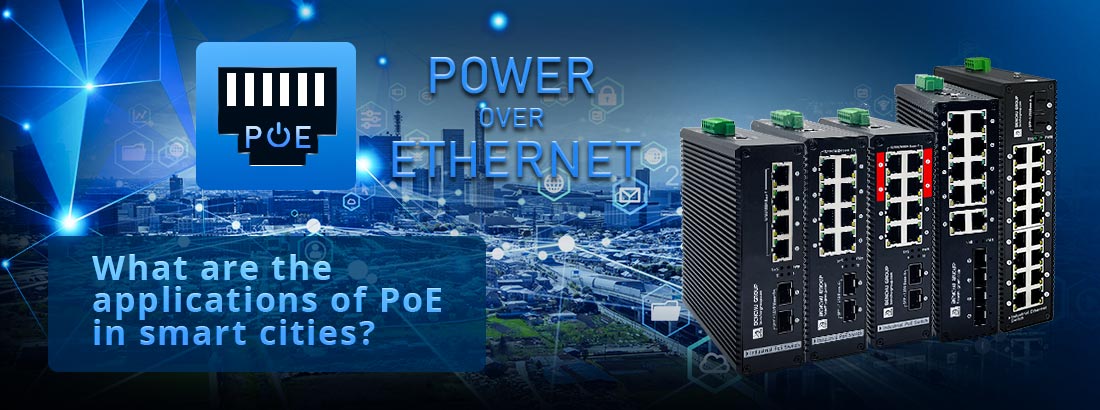
Power over Ethernet (PoE) plays a crucial role in smart city infrastructure by providing a flexible, cost-effective, and efficient means of powering a wide range of networked devices. Here are some key applications of PoE in smart cities:
1. Smart Lighting
Application: Smart street lights and outdoor lighting systems.
Benefits: PoE allows for the centralized management and control of street lighting. It supports energy-efficient LED lights and enables remote monitoring, dimming, and scheduling.
Example: Adaptive lighting systems that adjust brightness based on traffic or weather conditions.
2. Surveillance and Security Systems
Application: IP cameras, surveillance systems, and license plate recognition cameras.
Benefits: PoE simplifies the installation of security cameras by eliminating the need for separate power cables. It also supports high-resolution cameras and ensures reliable power delivery.
Example: City-wide CCTV networks for traffic monitoring and crime prevention.
3. Smart Traffic Management
Application: Traffic signal controllers, sensors, and smart traffic lights.
Benefits: PoE enables the deployment of advanced traffic management systems that can adapt to real-time traffic conditions, improving traffic flow and reducing congestion.
Example: Traffic signals that adjust based on traffic density and flow.
4. Environmental Monitoring
Application: Air quality sensors, weather stations, and environmental sensors.
Benefits: PoE powers these sensors, allowing cities to collect data on air quality, temperature, humidity, and other environmental factors. This data helps in making informed decisions for public health and urban planning.
Example: Sensors that monitor air pollution levels and provide real-time alerts.
5. Public Wi-Fi Access Points
Application: Wi-Fi hotspots in public areas such as parks, plazas, and transportation hubs.
Benefits: PoE facilitates the installation of Wi-Fi access points by providing power over the same Ethernet cable used for data, simplifying installation and reducing costs.
Example: Free Wi-Fi in city parks and downtown areas to enhance public connectivity.
6. Smart Kiosks and Digital Signage
Application: Interactive information kiosks, digital signage, and electronic billboards.
Benefits: PoE powers these devices while also providing network connectivity, enabling the display of dynamic content such as city information, advertisements, and real-time updates.
Example: Digital kiosks providing information on local events and public services.
7. Building Automation Systems
Application: Smart building controls for HVAC systems, lighting, and security.
Benefits: PoE powers building automation sensors and controllers, enabling energy-efficient operation and remote management of building systems.
Example: Automated climate control systems in public buildings and facilities.
8. Emergency Response Systems
Application: Emergency phones, alert systems, and public address systems.
Benefits: PoE ensures that these critical devices remain powered and operational during emergencies, improving response times and public safety.
Example: Emergency call boxes in city parks or along highways.
9. Transportation Hubs
Application: Smart ticketing systems, information displays, and security systems in airports, train stations, and bus terminals.
Benefits: PoE simplifies the deployment and management of devices in transportation hubs, improving the efficiency and experience for travelers.
Example: Digital information boards and automated ticket dispensers.
10. Smart Parking Solutions
Application: Smart parking meters, occupancy sensors, and parking guidance systems.
Benefits: PoE powers parking management devices, enabling real-time monitoring of parking spaces and providing information to drivers.
Example: Sensors that detect available parking spaces and guide drivers to open spots.
Benefits of PoE in Smart Cities:
1.Reduced Installation Costs: PoE combines data and power delivery over a single cable, reducing the need for additional wiring and minimizing installation complexity.
2.Flexibility and Scalability: Easily deploys and scales devices across the city, with the ability to add or relocate devices without major rewiring.
3.Reliability: Provides a stable and reliable power source for critical infrastructure, ensuring uninterrupted operation of smart city systems.
4.Centralized Management: Enables centralized monitoring and control of devices, allowing for efficient management and optimization of city services.
5.Energy Efficiency: Supports energy-efficient devices and smart systems that can adapt to changing conditions, contributing to overall energy savings and sustainability.
In summary, PoE is integral to the development and management of smart cities, enabling a wide range of smart applications that enhance urban living, improve efficiency, and support sustainability initiatives.